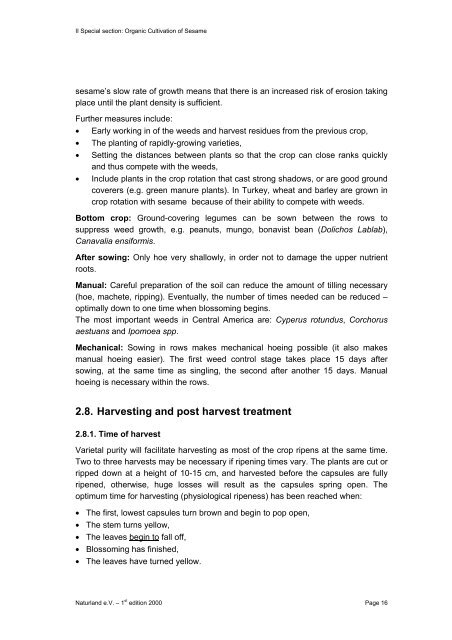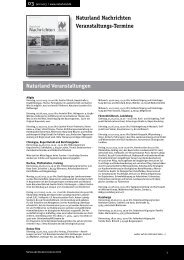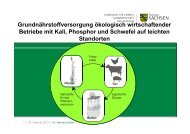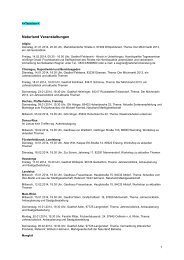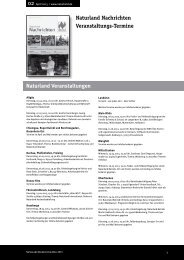Organic Farming in the Tropics and Subtropics: Sesame - Naturland
Organic Farming in the Tropics and Subtropics: Sesame - Naturland
Organic Farming in the Tropics and Subtropics: Sesame - Naturland
Create successful ePaper yourself
Turn your PDF publications into a flip-book with our unique Google optimized e-Paper software.
II Special section: <strong>Organic</strong> Cultivation of <strong>Sesame</strong><br />
sesame’s slow rate of growth means that <strong>the</strong>re is an <strong>in</strong>creased risk of erosion tak<strong>in</strong>g<br />
place until <strong>the</strong> plant density is sufficient.<br />
Fur<strong>the</strong>r measures <strong>in</strong>clude:<br />
• Early work<strong>in</strong>g <strong>in</strong> of <strong>the</strong> weeds <strong>and</strong> harvest residues from <strong>the</strong> previous crop,<br />
• The plant<strong>in</strong>g of rapidly-grow<strong>in</strong>g varieties,<br />
• Sett<strong>in</strong>g <strong>the</strong> distances between plants so that <strong>the</strong> crop can close ranks quickly<br />
<strong>and</strong> thus compete with <strong>the</strong> weeds,<br />
• Include plants <strong>in</strong> <strong>the</strong> crop rotation that cast strong shadows, or are good ground<br />
coverers (e.g. green manure plants). In Turkey, wheat <strong>and</strong> barley are grown <strong>in</strong><br />
crop rotation with sesame because of <strong>the</strong>ir ability to compete with weeds.<br />
Bottom crop: Ground-cover<strong>in</strong>g legumes can be sown between <strong>the</strong> rows to<br />
suppress weed growth, e.g. peanuts, mungo, bonavist bean (Dolichos Lablab),<br />
Canavalia ensiformis.<br />
After sow<strong>in</strong>g: Only hoe very shallowly, <strong>in</strong> order not to damage <strong>the</strong> upper nutrient<br />
roots.<br />
Manual: Careful preparation of <strong>the</strong> soil can reduce <strong>the</strong> amount of till<strong>in</strong>g necessary<br />
(hoe, machete, ripp<strong>in</strong>g). Eventually, <strong>the</strong> number of times needed can be reduced –<br />
optimally down to one time when blossom<strong>in</strong>g beg<strong>in</strong>s.<br />
The most important weeds <strong>in</strong> Central America are: Cyperus rotundus, Corchorus<br />
aestuans <strong>and</strong> Ipomoea spp.<br />
Mechanical: Sow<strong>in</strong>g <strong>in</strong> rows makes mechanical hoe<strong>in</strong>g possible (it also makes<br />
manual hoe<strong>in</strong>g easier). The first weed control stage takes place 15 days after<br />
sow<strong>in</strong>g, at <strong>the</strong> same time as s<strong>in</strong>gl<strong>in</strong>g, <strong>the</strong> second after ano<strong>the</strong>r 15 days. Manual<br />
hoe<strong>in</strong>g is necessary with<strong>in</strong> <strong>the</strong> rows.<br />
2.8. Harvest<strong>in</strong>g <strong>and</strong> post harvest treatment<br />
2.8.1. Time of harvest<br />
Varietal purity will facilitate harvest<strong>in</strong>g as most of <strong>the</strong> crop ripens at <strong>the</strong> same time.<br />
Two to three harvests may be necessary if ripen<strong>in</strong>g times vary. The plants are cut or<br />
ripped down at a height of 10-15 cm, <strong>and</strong> harvested before <strong>the</strong> capsules are fully<br />
ripened, o<strong>the</strong>rwise, huge losses will result as <strong>the</strong> capsules spr<strong>in</strong>g open. The<br />
optimum time for harvest<strong>in</strong>g (physiological ripeness) has been reached when:<br />
• The first, lowest capsules turn brown <strong>and</strong> beg<strong>in</strong> to pop open,<br />
• The stem turns yellow,<br />
• The leaves beg<strong>in</strong> to fall off,<br />
• Blossom<strong>in</strong>g has f<strong>in</strong>ished,<br />
• The leaves have turned yellow.<br />
Naturl<strong>and</strong> e.V. – 1 st edition 2000 Page 16


